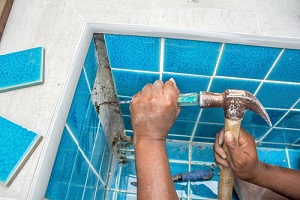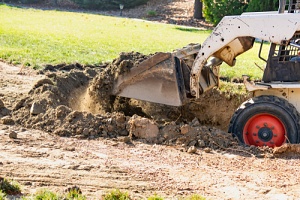 Homeowners may find themselves taking care of a pool that’s no longer used for more time than necessary because they’re concerned about removal costs. While a pool removal is an investment, going through with the process can free up your time, space, and future finances.
Homeowners may find themselves taking care of a pool that’s no longer used for more time than necessary because they’re concerned about removal costs. While a pool removal is an investment, going through with the process can free up your time, space, and future finances.
The costs of a pool removal can vary based on the type of pool you have, the type of removal selected, and other factors. However, this guide can give you a sense of what to expect and how to budget for your removal, allowing you to pursue the yard of your dreams with confidence.
The Benefits Of Removing A Pool
Removing a pool may be expensive, but it can ultimately save you thousands. Many homeowners find themselves paying up to $5,000 per year in regular maintenance and repairs, which can include everything from buying chemicals to replacing outdated filters.
Having a pool can also increase the amount of money you pay in homeowner’s insurance due to the increased liability a pool presents. After several years, a pool removal can end up paying for itself in savings, which can be used to fund other major goals and life events.
Save Time And Money
Choosing to remove your pool can also save you time. Maintaining a pool takes a considerable amount of time each week with chores like cleaning and checking chemical balances. It also requires you to spend time supervising small children and securing the pool area to prevent injuries. By removing your pool, you can instead dedicate this time to other pursuits and responsibilities.
Increase Your Home’s Value
In some cases, removing your pool increases the value of your home. If a pool is not a standard or common feature in your neighborhood, buyers may not be prepared for the extra work required to maintain it. Families with younger children may be particularly concerned about the pool’s safety. Removing it therefore opens up your home to a wider range of potential buyers, giving you a better chance of selling it for a good price if you choose to move someday.
Limit Potential Damage
 Finally, removing a pool limits the potential for damage in your backyard. Filters blocked by debris like plant matter can cause your pool system to flood the yard if they aren’t cleaned properly on a regular basis. In the winter, pools that have not been carefully closed can lead to cracked liners, which cost hundreds of dollars to replace and can cause dangerous leakage.
Finally, removing a pool limits the potential for damage in your backyard. Filters blocked by debris like plant matter can cause your pool system to flood the yard if they aren’t cleaned properly on a regular basis. In the winter, pools that have not been carefully closed can lead to cracked liners, which cost hundreds of dollars to replace and can cause dangerous leakage.
An excess of water around the foundation of your home can result in serious structural issues, making the home more dangerous and requiring immediate repairs. Removing your pool also removes the likelihood of damage like this occurring.
The Average Cost Of A Pool Removal
A pool removal generally costs anywhere from $2,700 to $7,000. For pools larger than 20 feet by 40 feet, full removals, or pools with particularly complex features, the price tag can be as high as $10,000.
Above Ground Pool Removals
Above ground pools are among the easiest to remove. Because they do not require a hole to be filled in, they can cost about $2,700 for removal. The process consists of draining the pool, unbolting and tearing down the walls, and hauling away the debris. Homeowners can then rebuild the area left behind. Adding grass and other landscaping elements can be a simple and affordable solution, while adding a new deck can cost around $7,000.
Inground Pool Removals
Because the process for removing an inground pool is more involved, the cost typically begins at around $5,000 for a partial removal and $9,000 for a full removal, which entails removing the entirety of the pool structure instead of just the top 18 inches. In both cases, the process begins by draining the water from the pool and drilling holes in the bottom before tearing down all or some of the pool structure. The cavity can then be filled in with fill dirt and compacted.
Fiberglass and vinyl pools are generally less expensive to remove because these materials can easily be cut and removed from the area. Concrete and gunite are heavier materials that need to be broken down with special equipment, making pools with these elements more expensive to remove.
Fill Materials
Depending on your yard goals, your contractor may recommend filling in the pool area with dirt or with concrete. Dirt typically costs about $60 to $100 per cubic yard, which accounts for the cost of labor. Speak with your contractor to see if dirt is included in their prices.
 Concrete is more expensive, costing about $100 per cubic foot. This translates to $500 to $800 in fill for a medium-sized pool. Concrete sets a more solid foundation because it doesn’t settle the way dirt might. However, dirt is a perfectly safe fill, so speak to your contractor if you have specific concerns or needs to determine which fill is best for you.
Concrete is more expensive, costing about $100 per cubic foot. This translates to $500 to $800 in fill for a medium-sized pool. Concrete sets a more solid foundation because it doesn’t settle the way dirt might. However, dirt is a perfectly safe fill, so speak to your contractor if you have specific concerns or needs to determine which fill is best for you.
Hiring An Experienced Pool Removal Contractor
While filling in a pool is expensive, budgeting for this investment can be worthwhile. Removing your pool saves you time and effort, gets rid of pool maintenance costs and worries, and can even improve your home’s overall value by providing a safe, beautiful yard for families who would rather avoid the hassle of managing a pool.
For more information about pool removals and to schedule your free consultation, contact Dirt Connections online. We have a long history of success in pool removals, and our experienced contractors can help you determine the right type of fill, pool removal, and timeline for your goals, allowing you to better plan and budget for your removal. Dirt Connections can also assist with a variety of home and commercial construction projects with services like construction plan development and fill dirt delivery.








































